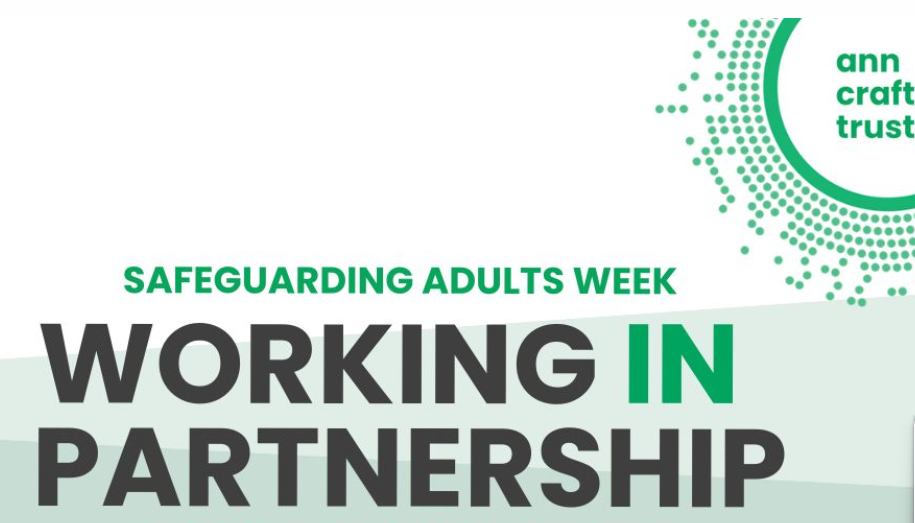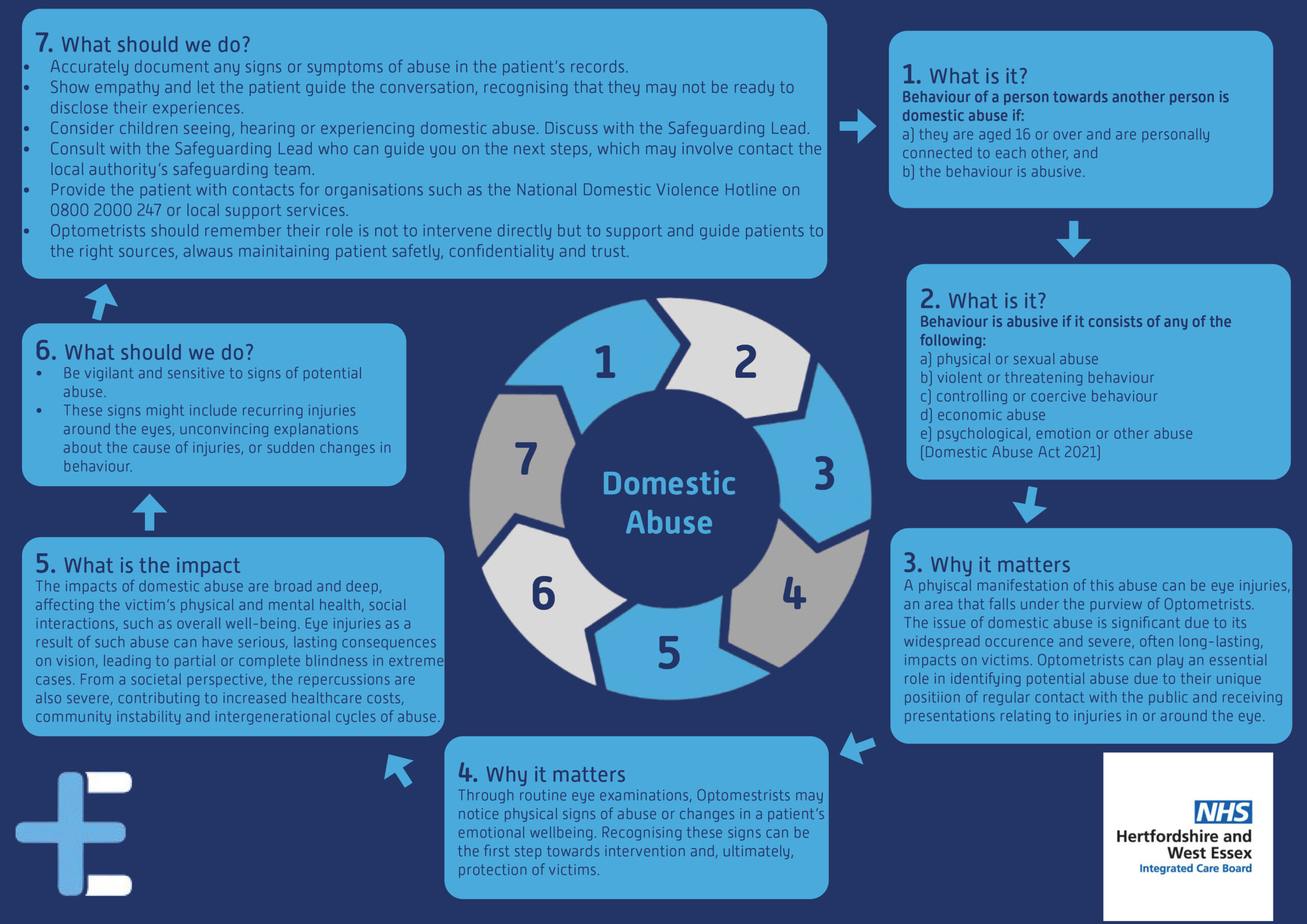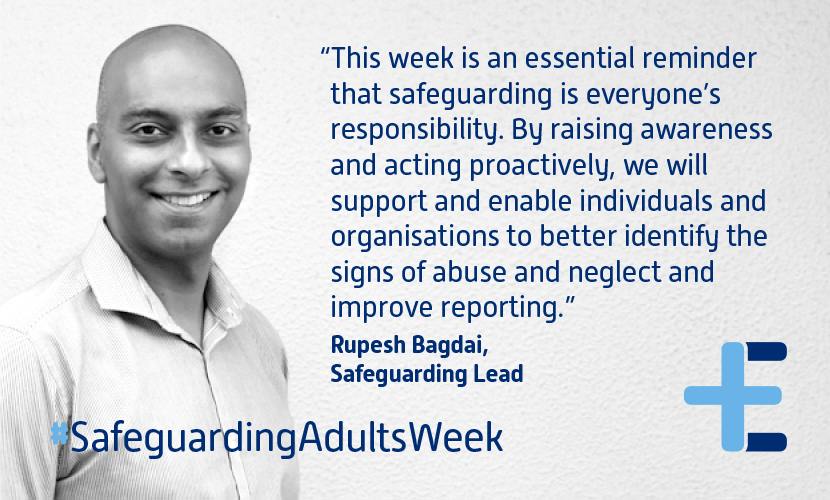Adult Safeguarding Week: Prevention, Protection, and Empowerment 18 – 24 November 2024
18 November 2024
This week is Adult Safeguarding Week – an annual campaign designed to raise awareness about protecting individuals who may not be able to protect themselves from harm, exploitation or neglect and to encourage a national conversation about preventing abuse and mistreatment.

In the UK, safeguarding is a statutory responsibility under the Care Act, 2014. Agencies such as local authorities, the NHS and social care providers all play a crucial role in identifying and responding to safeguarding concerns. Because eye health can sometimes reveal broader health or welfare concerns, our profession is in a unique position to observe signs of abuse, neglect or health issues that could require intervention.
Key Campaign Themes for 2024
Under the umbrella theme of Prevention, Protection and Empowerment, the campaign focuses on creating safer environments and highlights the importance of a collective responsibility for protecting at-risk adults.
Expanding upon the national campaign’s key areas of focus, over the next few days Primary Eyecare Services will be working to raise awareness of the following aspects of safeguarding:
Monday 18 November: Look, Listen, Ask – Developing Professional Curiosity
Professional curiosity is a practice mindset and communication skill that involves exploring and understanding what is happening by asking questions, maintaining an open mind and not relying on one single source of information or taking things at face value.
Practitioners are therefore urged to take the following steps:
Look – Is there anything about what you see that makes you feel uneasy?
Listen – Does something not sound right?
Ask – Are there questions you can ask to explore what you have seen or been told? Who else can you talk in and outside your practice to follow up concerns?
For more information – see here for guidance issued by the North Yorkshire Safeguarding Board. It has been created for all professionals working with children, young people, parents, carers and adults with care and support needs.
Tuesday 19 November – Making Safeguarding Personal
Launched in 2009 and included in the Care Act (2014), Making Safeguarding Personal (MSP) focuses on placing the individual at the centre of safeguarding practices.
By emphasising personalised outcomes, it ensures that safeguarding actions reflect an individual’s unique needs, preferences and desired outcomes, rather than simply following procedural steps. As far as possible, the at-risk adult remains fully engaged and consulted throughout, with their wishes and opinions central to the final outcome.
MSP specifically involves:
Listening to the person in question
Asking them what outcome they want
Recording their views as they have expressed them
Sharing this on any referral to safeguarding leads
In 2019, the Local Government Association in conjunction with ADASS published a series of case studies called Making Safeguarding Personal. Its content spans a range of examples of safeguarding in practice, all demonstrating the effect of using outcome-focused practice benefitting both councils and individuals. Of particular relevance is case study number four on page 13.
Wednesday 20 November – Domestic Abuse
Domestic Abuse is the most common form of abuse identified in our Community Urgent Eye Care Services (CUES). It can often go unnoticed to outsiders for long periods of time so it is therefore vital to be aware of signs so that it can be identified as soon as possible.
See below for our 7-step briefing on Domestic Abuse and what to do if you come across indications that this is happening:

Useful resources outlining the various types of domestic abuse that may occur and show signals to look out for can be found here:
NHS Safeguarding Guidance (2024): Domestic abuse – NHS Safeguarding
Home Office Statutory Guidance (2022): Domestic Abuse Statutory Guidance
National Institute for Health and Care Excellence (NICE) Quality Standard for Domestic Violence and Abuse (2024): Domestic violence and abuse
Two recent UK documentaries exploring different aspects of the subject and how they impact people in different ways are available online at:
My Wife, My Abuser: My5 – My Wife, My Abuser: The Secret Footage – Season NaN – Episode 1 / My Wife, My Abuser: The Secret Footage
Is This Coercive Control: Is This Coercive Control? – BBC iPlayer
Thursday 21 November – County Lines and Cuckooing
What are County Lines?
The Home Office’s Serious Violence Strategy defines County Lines as:
‘A term used to describe gangs and organised criminal networks involved in exporting illegal drugs into one or more importing areas within the UK, using dedicated mobile phone lines or other form of “deal line”. They are likely to exploit children and vulnerable adults to move and store the drugs and money and they will often use coercion, intimidation, violence (including sexual violence) and weapons.’
County lines can refer gangs and organised criminal networks involved in exporting illegal drugs into areas across the UK. They are likely to exploit children and at-risk adults and often use coercion, intimidation and violence to recruit, transport and exploit people to undertake carry out criminal activities such as preparing, moving, storing and dealing illegal drugs.
For further information about County Lines issue and how it is being addressed see County Lines | Crimestoppers
What is Cuckooing?
Cuckooing is a common feature in County Lines exploitation where criminals take over the home of an at-risk adult. The property is the used as a base for criminal activity. Click here for two case studies that illustrate the issue:
County Lines and Cuckooing guidance are both detailed in a government paper here.
Friday 22 November – Professional and Organisational Learning
To effectively safeguard at-risk adults and establish safer cultures, it is important for optometrists and their wider teams to be engaged in a process of continual learning and development. Today’s theme encourages professionals to reflect on their practice. What have been the successes and the challenges in safeguarding adults so far? What work is yet to be done and how can team learning be developed further?
All optometrists can access free Safeguarding training through DOCET
Saturday 23 and Sunday 24 November – What Is Cyberbullying?
What is Cyberbullying?
Cyberbullying refers to the use of internet and/or mobile technology to harass, intimidate, or cause harm to someone, causing a detrimental impact on the person targeted. See here for guidance issued by www.stopbullying.gov on more the type of tactics employed and some case studies.
It can take place over any digital device including mobile phones, computers, and tablets. It can also occur via SMS, texts, WhatsApp or online on social media, or in forums and gaming where people view, participate in, or share, content.
Cyberbullying involves sending, posting, or sharing negative, harmful, false or cruel content about someone else. It can include sharing personal or private information resulting in embarrassment or humiliation. Some cyberbullying crosses the line into criminal behaviour.
See here for guidance issued by www.stopbullying.gov for on more about the type of tactics employed and some case studies.
See below for wider resources and information about keeping safe online:
Safety – online – Better Lives Healthy Futures
How to Stay Safe Online – Guidance for Adults and Young People with Learning Disabilities – Digital Safeguarding – Ann Craft Trust
Online Safety Guides – Social Media – The Online Safety Centre
Our Professional Duty of Care
For optometrists, safeguarding encompasses a range of responsibilities centred on the protection and well-being of patients of all ages. Key to undertaking these duties effectively is an awareness of how to approach safeguarding with sensitivity, knowledge of local reporting protocols and the need to balance patient confidentiality with our professional duty of care.

Safeguarding for optometrists involves not only identifying these signs but also to report concerns in line with current legal and ethical standards, such as the Care Act 2014 and the General Optical Council’s safeguarding guidelines.
To find the contact details for your local government safeguarding team, click here.
See also the NHS Safeguarding Guide which provides a comprehensive guidance framework healthcare professionals, carers and members of the public to increase awareness and understanding of safeguarding.
Primary Eyecare Services’ Named Safeguarding Lead is Lisa Gibson who is trained to offer our practitioners and their wider teams support with any concerns.